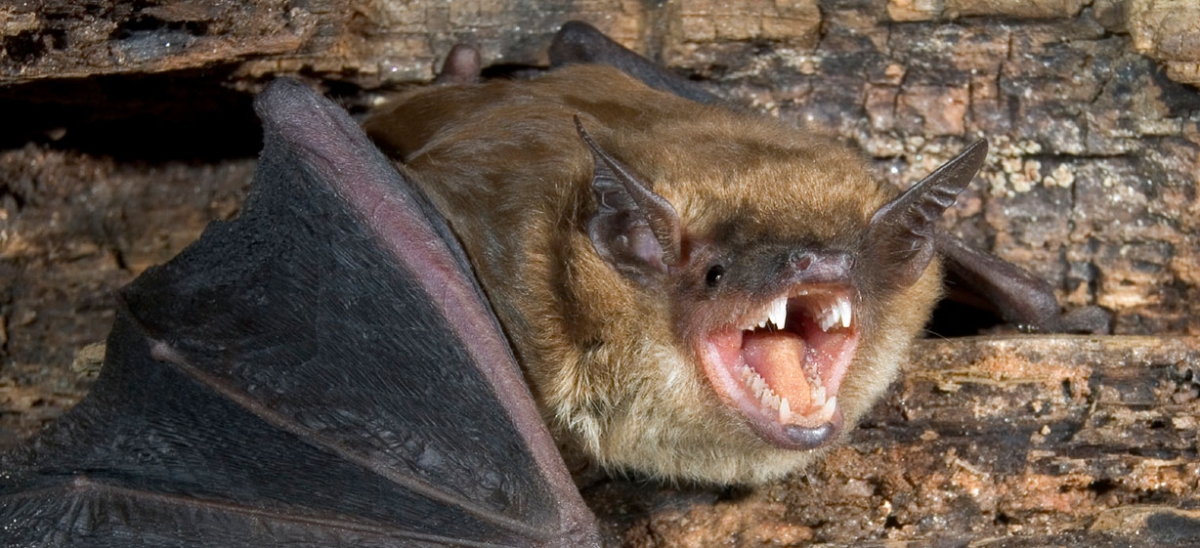
In 1967, we arrived at our island cottage in Michigan’s Upper Peninsula, and of course, the first thing we kids did was explore our distantly familiar summer home. On that particular day, we found a bat inert on the dining room floor.
“Pick it up, and we’ll show Dad,” said my 14-year-old sister. I was five, but I knew not to use my fingers and got two Styrofoam coffee cups, pushing it into one. As I navigated the rocky path down to the boathouse where my parents were having cocktails, I stumbled, and the bat fell to the ground. I couldn’t get it back into the cup, so I pushed the bat in with my finger. At that moment, it came to life and bit me.
When I got to the boathouse and told Dad, his smile disappeared. The next day, the bat was sent to Lansing for rabies tests, which came back negative. Had it been positive, my relieved mother told me, I would have needed a series of terrible shots. The next day, however, we learned that a new state law required anyone bitten by a bat to have the shots. So my ordeal began. For the next 14 days, I walked with dread to a nearby cottage, where I clutched my mother’s hand as old Dr. Wagner lifted my shirt, swabbed me with alcohol and stuck the long needle directly into my stomach. I still have a poster my other sister made for me, entitled “Cross off the Creepy Bat Shot Days as They Go By,” with a box for each day, which I covered with vehement pencil scratches.
Since then, I’ve had a special sonar for bat information. At nine, I read a newspaper story about a boy my age driving a boat across a Maine lake. He was hit in the forehead by an errant bat and died of rabies, which causes a horrific death.
When I came to Pittsburgh in 1985 for a newspaper internship, my first assignment was to go to a basement laboratory at Duquesne University, where a scientist was studying bat flight physiology. The enormous Madagascar bats, with bodies a foot from head to tail and six-foot wingspans, flew in a wind tunnel in the darkened room, illuminated only by a strobe light’s periodic flash. Bats, I learned, are the super-evolved metabolic champions of the mammal world, with metabolisms 1,000 times that of the greatest Olympic athlete.
Over the years, my respect for and knowledge of bats has grown, largely because our old cottage has been home to generations of bat families. They get in through tiny cracks, scramble up the interior walls and roost in the attic.
“Dad, what’s that motorcycle sound in the wall?” our oldest son once asked when I was putting him to bed. The house, at times, has literally crawled with bats (try putting your children to bed with that knuckling and screeching…)
Of course, when they stayed behind the walls and in the attic, it was generally okay. But imagine having guests over in the living room and hearing someone yell: “Bat!” They swoop and circle unpredictably, darting right at you, then away. There’s no more effective way to end a party…. For years, we kept a tennis racket in every room for bats. But 20 years ago, we became more enlightened, using butterfly nets to capture bats, then letting them go free outside. I’ll add here that despite my being 6’2” and 210 pounds (about 900 times larger than the little brown myotis bat), I can’t help but be irrationally creeped out when a bat flies into the room. It may be the one area where my wife is more cool-headed than I. If a bat came into our bedroom at night, I generally hid under the covers while my wife caught it.
We’ve tried everything to keep them out of the living space—from plastic owls and annoying sound devices to patching every possible crack. About 20 years ago, we hired a bat expert (named Willard), who guaranteed his bat proofing. Despite his best efforts, however, the bats stayed with us. Three years ago, we hired Willard again, reminding him he’d been there before. “Oh, I’ve gotten a lot better,” he said. “I wouldn’t have hired me back then.”
One late fall day 15 years ago, I received a call in Pittsburgh asking if I would give the annual speech the next summer to the islands association—on bats. It was an honor, and I was feeling proud of myself that afternoon as I readied our Squirrel Hill home for winter. One of the last tasks was bringing in the window boxes. I put the aluminum extension ladder against the house and climbed the 18 feet to the second-floor window. I should have had a spotter, but didn’t. At the top, I clenched the rickety ladder with my knees and with both hands lifted the heavy window box off of its supports. There I was, hands full, knees grabbing the ladder—when five inches in front of my vulnerable face was a bat who’d been hiding under the window box. He awakened, looked right at me and seemed ready to take a bite out of my nose. In probably the greatest effort of will in my life, I quelled my first instinct—to scream, throw the box, and jump off of the ladder—and slowly descended.
* * *
Early this summer, we put a new roof on the cottage, and the roofer called to say that after he removed the old shingles, he’d found a few major bat entry ways. “Yes, by all means, patch them,” I said. “We’ll pay the extra $300.” When we arrived in June and met with him to pay the bill, I complimented his work, saying we’d neither seen nor heard a bat. He declined the credit, though; no one in our islands had seen a bat.
As it turns out, the white-nose syndrome that has decimated bat populations in so many states hit Michigan last winter. And the timing was terrible. The fungus interrupts bat hibernation, sapping the energy they need to survive the winter. Last winter in Michigan was one of the coldest and longest in memory, and the 90 percent bat mortality that usually takes a few years appears to have happened in a single year.
Yes, there were no bats in the cottage this summer. But no bats anywhere? All my life, I’ve both dreaded and marveled at these little creatures. I’ve hung bat houses all around the cottage to persuade them to stick around, just not in our house. And now, the bats are gone. An entire species in a huge region has vanished.
Certainly it’s meant a huge increase in bugs of all kinds, including mosquitos. And it’s no stretch to realize that if an incredibly adaptable and advanced species can disappear in a few months, obvious possible parallels exist for other mammals, including us. For me personally, however, summer life without “our little friends” will be so much less rich. So much less mysterious.
Late one night 25 years ago, a friend who’d returned from Africa told a group of us perched on the porch steps a long and fascinating story about an African dog that had gone mad with rabies. The colorful tale began with the appearance of a bat in a nearby hut one day. The mesmerizing saga wove in columns of red army ants, Africans with spears and an annoying dog who became a menacing Cujo whose head ultimately was cut off, placed in a plastic bag and sent to the city for testing. My friend ended the amazing story, saying “and they traced it all back to that bat.” As if on cue, a bat flew the length of the porch and dove down at the mosquitoes above our heads—sending us all shrieking and running into the house. Nevermore… nevermore…



